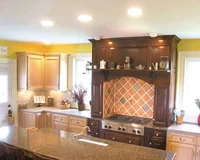Finished
kitchen cabinets are emitting toxic PCBs
 First-of-its-kind
study finds finished cabinetry is a major source of PCBs inside people's homes;
scientists suspect wood sealants are the culprit.
First-of-its-kind
study finds finished cabinetry is a major source of PCBs inside people's homes;
scientists suspect wood sealants are the culprit.
Researchers tested indoor air at 16 homes and found three types of PCBs
are widespread and finished cabinets are the source of the toxics, according to
a study.
They
suspect the PCBs [polychlorinated biphenyls] are byproducts of sealants used on
the cabinets.
The study, from the University of Iowa, is the first to suggest wood finishing products are a significant source of PCBs to indoor air and finds that, despite federal bans on PCBs, the chemicals are still being released into the environment, including our homes.
The study, from the University of Iowa, is the first to suggest wood finishing products are a significant source of PCBs to indoor air and finds that, despite federal bans on PCBs, the chemicals are still being released into the environment, including our homes.
"The magnitude of these emissions is big," said Keri Hornbuckle, a professor of civil and environmental engineering at the University of Iowa and senior author of the new study, published in Environmental Science and Technology. "And no monitoring network inside our home would catch something like this."
PCBs
were used in electrical equipment and as industrial solvents. The chemical
family was banned in the 1970s amid concerns that PCBs accumulated in wildlife
and people and were linked to reduced IQs, cancer and suppressed immune
systems.
Levels of the long-lasting compounds in the environment and our bodies have been steadily decreasing since the ban.
Levels of the long-lasting compounds in the environment and our bodies have been steadily decreasing since the ban.
The
amount of indoor emissions found in the current study is "similar to if
you had an old light ballast in your house," Hornbuckle added, referring
to a common source of PCBs from before they were banned.
"This
is a really important finding in terms of potential health risks to people and
vulnerable populations—and pets," said Alicia Timme-Laragy, a researcher
and assistant professor at UMass-Amherst's School of Public Health and Health
Sciences.
"Who
would think kitchen cabinets would be a source of PCBs?" added Laragy, who
was not involved in the study.
Hornbuckle
and colleagues found three types of PCBs— PCB-47, PCB-51, and PCB-68. They
found more of the chemicals in newer and reconstructed homes.
The
homes tested were in and around Iowa City, Iowa.
"We
know very little about these compounds, they've been under the radar. We don't
know their potential developmental impacts, we don't know their
half-lives," Laragy said.
There
is some nascent research—and it doesn't look good.: PCB-47 has been linked
to liver problems; both PCB-47 and PCB-51
can disrupt hormones, and all three of the PCBs
found in finished cabinetry "have neurotoxic potential," the
authors wrote.
Miroslav
Machala, head of the Department of Chemistry and Toxicology at the Veterinary
Research Institute in the Czech Republic, said in an emailed response that,
while these specific compounds lack data, these types of PCBs could potentially
promote tumor growth as well.
"Metabolites
of PCBs may also exert toxic effects," Machala added, referring to new
compounds formed when the chemicals break down.
The
cabinets tested were made by different companies, so it seems it's not a
particular company at fault, rather the PCBs are byproducts of a process used
by all cabinet makers. Unfinished cabinets tested had no PCBs on them.
The
Cabinet Makers Association did not return requests for comment on the study.
It
was already known that PCBs existed in polymer products, such as silicone and
polyester, which are used to finish, seal and protect wood products like
cabinets, however, researchers hadn't pinpointed the products as sources of
PCBs to the environment.
Part
of the reason: testing is tricky—Hornbuckle and colleague used a very sensitive
test that picks up many PCBs, a technique not many scientists or regulators
use. PCB-47 can also be in the air due to legacy sources of PCBs, so the
cabinets may have been missed as a source in the past.
Finished
cabinets aren't the only ongoing source of PCBs—pigment manufacturing,
especially yellow pigment, is also a major source, specifically for PCB-11.
We reported last month that PCB-11 remains steady in Great Lakes air, while all legacy PCBs in the region are on a steady decline.
We reported last month that PCB-11 remains steady in Great Lakes air, while all legacy PCBs in the region are on a steady decline.
In
Hornbuckle's new study, PCB-11 was also found inside every home, and was often
the most prevalent airborne PCB.
Under
the Toxics Substances Control Act the U.S. Environmental Protection Agency
allows some PCBs in manufacturing as "unintentional impurities."
An
EPA spokesperson said "this may be the first report that proposed a new
source of the target PCB congeners in residential indoor air. However, we would
need to further evaluate the results with respect to other potential sources of
PCBs before making any more definitive statement."
Laragy
said these unintended byproducts can carry big risks.
"I
worry about babies brought into a home with exposures like this," Laragy
said. "I worry about kids with asthma and adults with COPD [chronic
obstructive pulmonary disease]."